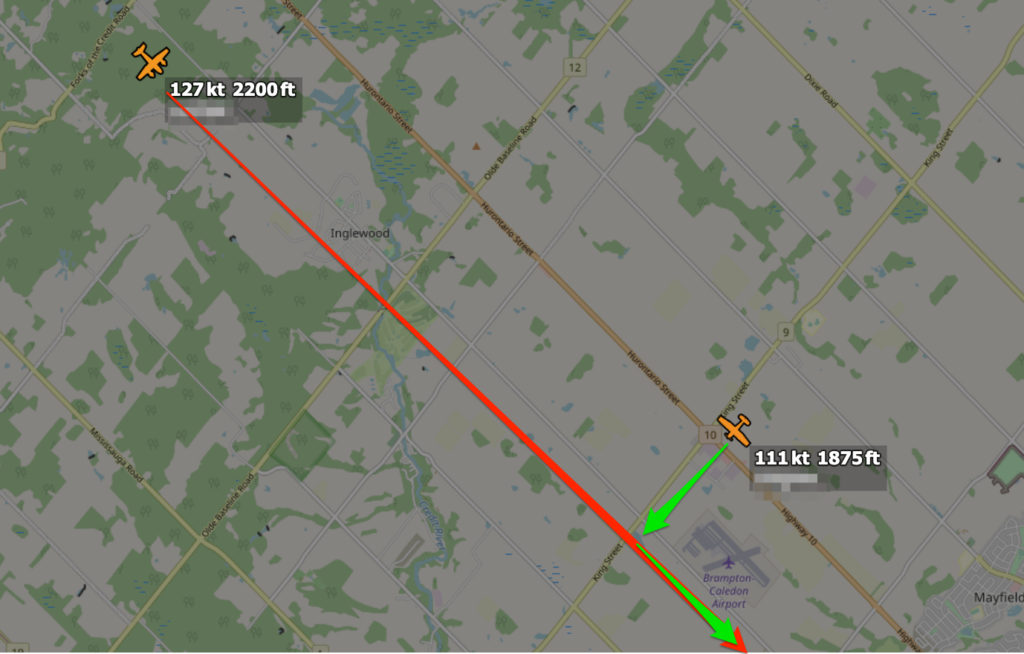Two airplanes are approaching an aerodrome at the same time. One is planning the straight in downwind for runway 33. The other, is planning on joining the mid-left downwind for 33.
Both circuit entries are allowed by law (in Canada) in this situation as this is an uncontrolled airport. Both aircraft had made their required calls and are continuing to converge on the downwind leg of the circuit. Who has the right of way in this situation?
This exact same scenario happened to me this past weekend when trying to land at Brampton (CNC3). I’m aircraft #2 in the scenario. At this moment in time a few things are going through my head:
- Aircraft #1 just made a radio call that they are over the town of “Inglewood”, 3 miles away from the airport.
- Using the ADSB traffic data from my GTX375, I notice that the aircraft is moving much faster than me and assume its a twin engine aircraft (it was).
- Knowing that my speed will be 20-30kts slower than him in the circuit I decided it was up to me to figure out what to do next.
In hindsight and after debriefing this situation with other pilots. I see two possible safe outcomes:
- Perform a 360 degree turn on the upwind side of the airport and wait for the twin to pass mid downwind. 33 has standard left hand circuits, so the east side of the airport is “dead” and wont have any traffic to worry about (unless someone else is approaching from the east).
- Continue overflying the field at circuit height (1900′) to join the mid-left downwind in front of the twin engine aircraft.
I did neither of these two things:
Not the smartest idea. Here’s why:
- Turning into the the departure end of 33 would have caused a conflict with aircraft taking off.
- Climbing from 1900 to 2400 to try to get “above” the twin as it descended put me at risk of a collision since we were both at the same altitude and place at the same time.
- This is a non-standard behaviour that other pilots would not have expected.
In the end everyone landed safely. But it begs the question: Who has the right of way in this scenario?
Naturally I went to the Canadian Aviation Regulations for guidance:
CAR 602.19 – Right Of Way: General
- (8) The pilot-in-command of an aircraft that is approaching an aerodrome for the purpose of landing shall give way to any aircraft at a lower altitude that is also approaching the aerodrome for the purpose of landing.
- (9) The pilot-in-command of an aircraft at a lower altitude, as described in subsection (8), shall not overtake or cut in front of an aircraft at a higher altitude that is in the final stages of an approach to land.
Confusing isn’t it? Considering I was already at circuit altitude, paragraph 8 says I had the right of way. However, paragraph 9 states that the twin may have had the right of way. What is the “final stages of an approach to land”. Is that the final leg in the circuit? Is what I would have done considered to be “cutting them off”?
Surely the Aeronautical Information Manual (AIM) will have some insight.
It’s important here to pause and go over the difference between “priority” and “right of way”. No aircraft, no matter how big, fast, high, or low, has priority over another aircraft. The only exception to this is Medevac and flights for fire fighting. This is illustrated in the AIM:
Some pilots operating under VFR at many sites prefer to give commercial IFR and larger type of aircraft priority. This practice, however, is a personal airmanship courtesy, and it should be noted that these aircraft do not establish any priority over other aircraft operating VFR at that aerodrome.
RAC 4.5.2
Finally the AIM states:
(e) For aerodromes not within an MF area: Where no MF procedures are in effect, aircraft should approach the traffic circuit from the upwind side. Alternatively, once the pilot has ascertained without any doubt that there will be no conflict with other traffic entering the circuit or established
RAC 4.5.2
within it, the pilot may join the circuit on the downwind leg
This paragraph is how I’ve interpreted the situation. I was already in the circuit because:
- I was at circuit altitude (1900′)
- I was on the upwind side and crossing over the field.
- The AIM states that a straight in downwind entry should only be attempted if no conflict exists.
Therefore I should have continued with the entry into the mid left downwind (option 2 at the start of this article).
Trying to be a good airman by giving way to the faster twin may have made the situation worse. Hindsight is 20/20, but debriefing situations like this will always make you a better pilot.




